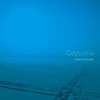Martin Schulte, "Odysseia"

On his second album, this young Russian artist, a.k.a. Marat Shibaev, continues his infatuation with the sparse, dub infested blend of minimalist electronic music popularized by the likes of Porter Ricks, but with his own personal touch. The result is just the right balance of repetitive electronic thump and abstract textural explorations.
Odysseia is heavily based on muffled, repetitive analog kick drum thumps and bassy synth pads, creating a murky nautical sound that feels as if it’s being played deep under the sea.The opening "Abyss" exemplifies this, with wave-like reverberated noises with the buried analog drums, but dynamic improvisational squelches present as well.The clash between the repetitive beats and ambience with the vibrant, abstract rattling creates a powerful synergy in which the track becomes repetitive without being dull, and chaotic without being formless.
Minuscule clicks and oceanic organ passages on "Polaris" keep this vibe alive, tossing waxy random sounds in amongst the otherwise repeating beats.Even the venerable 808 hand-clap sounds make an appearance in "Researches of Depths" within the deep kick drums and subsonic bass line.
While there is a comfortable familiarity with the 4/4 bass drum programming, Shibaev isn't afraid to tinker with the formula to try new things.The erratic rhythms and less obvious sounding drum hits of "Immersing" sounds more like an intentionally random scattering of sonic fragments within the sea.The more spacious "Solar System" focuses less on the rhythm and more on the textures, with wavy noise stabs and raw analog synth notes defining the piece."Mermaid" is similar in placing a greater emphasis on the deep minor chords, creating a darker, more claustrophobic sheen over the track.
Amongst the final two songs is where the dub influences shine through most."Spirits" is first and foremost a rhythm based piece, with the ambient textures scaled back to display the complex programming of the beats, utilizing appropriate amounts of echo and reverb.The closing "Reverberation" feels like a return to the surface after the deep explorations prior, with the less murky synths allowing the light to shine through.The result is not only more upbeat, but its treated rhythms and shaker percussion resemble dub in its most traditional form.
While the songs here do feel as if they have a definite formula to them, it is one that accommodates enough variables to allow them to develop their own identities, creating an album that feels thematically cohesive, but not overly repetitive.The rhythm programming is perhaps the most static element here, but even that has enough variation to keep the album fresh.What's here has been done before, but here it’s done well enough for this fact to be irrelevant.
samples:
 




